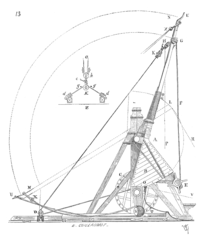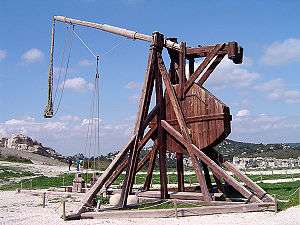Mangonel
A mangonel[1][2][3] was a type of catapult or siege engine used in the medieval period to throw projectiles at a castle's walls. A mangonel had poorer accuracy than a trebuchet (which was introduced later, shortly before the discovery and widespread usage of gunpowder). The mangonel threw projectiles on a lower trajectory and at a higher velocity than the trebuchet, with the intention of destroying walls, rather than hurling projectiles over them. It was more suited to field battles.
Mangonel is derived from the Greek mágganon, meaning "engine of war", but mangonel may also be indirectly referring to the mangon, a French hard stone found in the south of France. It may have been a name for counterweight artillery (trebuchets), possibly either a men-assisted fixed-counterweight type, or one with a particular type of frame.[4][5] The Arabic term manajaniq comes from the same word, and applies to various kinds of trebuchet. It is also possible that it referred to more than one kind of engine, in different times or places, or was a general term.
Role in war
Traction trebuchets (which may be what are referred to as mangonels in medieval sources) were beam-sling weapons, similar to trebuchets. They were used to hurl rocks, burning objects (fire pots, vessels filled with flammable materials that created a fireball on impact), or anything else readily available to the attacking and defending forces. The medieval mangonel was principally used in siege warfare to damage a castle or city's walls and infrastructure, or to harm or harass defending troops.
The more unusual types of projectile included dead (and often partially decomposed) carcasses of animals or people (and even human heads), used to intimidate, demoralize, and spread disease among the besieged. This tactic often proved effective. The short supply of food, which was often of low quality or rotting, combined with the cramped living space of the defenders, poor hygiene, and vermin infestations, provided an ideal scenario for the spread of disease.
Popular depictions of onager-like mangonels often show them shooting heavy projectiles from a bowl-shaped bucket at the end of the arm . This arrangement might suit a wider range of projectiles, but would be much less powerful than a weapon fitted with a sling.
Middle ages


The mangonel in the Middle Ages had a different connotation from the Roman onager. It was more similar to the counterweight-powered trebuchet; the primary difference was that the pulling power of several men was used instead of the trebuchet's falling counterweight. This way, with trained workers, the leader of the craft could adjust the strength applied to the mangonel. It is possible that hybrid mangonel-trebuchet engines existed, with both pulling men and a falling counterweight.
Working system of the mangonel
The hybrid mangonel-trebuchet might be loaded by lowering a rope with a hook at its end; this hook was tied to another rope connected to a "pulling" system (this could be a pulley compound, a gear compound, or even an animal traction system) to pull the rope and lower the main beam. Once the beam was lowered a few workers were responsible for the attachment of a sling where the projectile was placed. When the mangonel was loaded the leader gave the order to release the main rod, and at the same time several men (usually around 20) pulled the ropes attached to the counterweight.
Well-trained crews could control whether the projectile traveled in a low or high trajectory, which is set primarily by the fore-aft position of the sling. Poorly trained crews faced the risk of the projectile killing friendly troops or even the crew itself.[6]
See also
References
- ↑ "What is a catapult?". RLT Industries. Retrieved 2009-01-12.
- ↑ "Mangonel". middle-ages.org.uk. Retrieved 2009-01-12.
- ↑ from Old French or Norman mangonel(le), French mangoneau, itself from Medieval Latin manganellus, mangonellus, from Greek μάγγανον meaning "engine of war", "axis of a pulley". T. F. Hoad, The Concise Oxford Dictionary Of English Etymology, Oxford Paperbacks, Oxford University Press, 1993, p. 280a.
- ↑ Konstantin Nossov; Vladimir Golubev. Ancient and Medieval Siege Weapons: A Fully Illustrated Guide to Siege Weapons and Tactics.
- ↑ Larry J. Simon; Robert Ignatius Burns; Paul E. Chevedden; Donald J. Kagay; Paul G. Padilla. Iberia and the Mediterranean World he Middle Ages: Studies in Honor of Robert I. Burns, S.J.
- ↑ "Dictionnaire raisonné de l’architecture française du XIe au XVIe siècle - Tome 5, Engin".
External links
| Wikimedia Commons has media related to Catapults. |
- Res Gestae, 4th century, by Ammianus Marcellinus
- Medieval Mechanical Artillery, by the Xenophon Group
- Onager Physics. An analysis of the Onager/Mangonel
- Mangonel Animation
